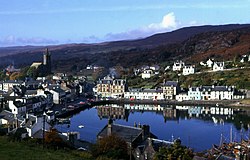Tarbert, Kintyre
| Tarbert Gaelic: Tairbeart Loch Fìne/An Tairbeart | |
| Argyllshire | |
|---|---|
 A view over Tarbert Harbour | |
| Location | |
| Grid reference: | NR865685 |
| Location: | 55°51’46"N, 5°24’41"W |
| Data | |
| Population: | 1,338 (2001) |
| Post town: | Tarbert |
| Postcode: | PA29 |
| Dialling code: | 01880 |
| Local Government | |
| Council: | Argyll and Bute |
| Parliamentary constituency: |
Argyll and Bute |
Tarbert is a village on the boundary between Knapdale and Kintyre in Argyllshire. It is built around East Loch Tarbert, an inlet of Loch Fyne, and extends over the isthmus which links the Kintyre peninsula to Knapdale and West Loch Tarbert. Tarbert had a recorded population of 1,338 in the 2001 Census. The village lies on the boundary between the parishes of South Knapdale and Kilcalmonell.
Tarbert has a long history both as a harbour and as a strategic point guarding access to Kintyre and the Inner Hebrides. The name Tarbert is the anglicised form of the Gaelic word tairbeart. It is composed of tar "across" and a form of the verb beir "carry" and literally translates as "across-carrying". This refers to the narrowest strip of land between two bodies of water over which goods or entire boats can be carried (portage). In past times cargoes were discharged from vessels berthed in one loch, hauled over the isthmus to the other loch, loaded onto vessels berthed there and shipped onward, allowing seafarers to avoid the sail around the Mull of Kintyre.
Tarbert was anciently part of the Gaelic overkingdom of Dál Riata and protected by three castles — in the village centre, at the head of the West Loch, and on the south side of the East Loch. The ruin of the last of these castles—Tarbert Castle—still exists, and dominates Tarbert's skyline. Around the year 1098 Magnus Barefoot, King of Norway, had his longship carried across the isthmus at Tarbert to signify his possession of the Western Isles.
Despite its distinction as a strategic stronghold during the Middle Ages, Tarbert's socioeconomic prosperity came during the Early Modern period, as the port developed into a fishing town. At its height, the Loch Fyne herring fishery attracted hundreds of vessels to Tarbert.
History

Tarbert is a name from Gaelic for a small neck of land joining two larger pieces; an isthmus, at which Tarbert lies.
Tarbert was anciently part of the Gaelic overkingdom of Dál Riata. It has been suggested as a scene of an action during a conflict for the kingdom's rule between Dúngal mac Selbaig and Eochaid mac Echdach. The Annals of Ulster attest that in 731, Dúngal burnt a "Tairpert Boitir", which was most probably Tarbert and was at the time in the lands of the Cenél nGabráin.[1]
Around the year 1098 Magnus Barefoot, King of Norway, had his longship carried across the isthmus at Tarbert to signify his possession of the Western Isles.
A fortified structure was built in Tarbert during the 13th century. It was reinforced with the addition of an outer bailey and towers in the 1320s by Robert the Bruce, to protect it against the Lords of the Isles. A towerhouse was added in the 16th century, which is the most noticeable part of the remains. The castle occupies high land above Loch Fyne, providing views up East Loch Tarbert and beyond to the Firth of Clyde. This castle was captured from John MacDonald by James IV as part of his campaign to destroy the power of the Lords of the Isles. In 1685 the castle was involved in another skirmish when Walter Campbell of Skipness Castle seized it as a stronghold for the Clan Campbell.
There are only a couple of standing walls left and they are considered unstable. The castle is on top of a hill in Tarbert overlooking the bay. The castle has a very commanding view of the water approaches.
Geography

The coast of Tarbert Bay is rocky and the cliffs are fringed with young firs, the village itself being an extremely tranquil and beautiful place. The parish church occupies a fine situation. Overlooking the harbour are the ruins of a castle built by Robert I in 1326. The isthmus connecting the districts of Knapdale and Kintyre is little more than one mile wide, and boats once used to be dragged across to the head of West Loch Tarbert, a narrow sea loch nearly ten miles long. A proposal to cut a canal across to shorten the sail to Islay and Jura has never progressed further. Tarbert is famous for its seafood and hosts a seafood festival every year.
In addition to the Seafood Festival, Tarbert also plays host to the Scottish Series, which usually takes place in the last weeks of May every year. This yacht race is the second biggest in Britain and is surpassed only by the Cowes Week. At its peak, the village is swelled by visiting yachtsmen and their yachts.
The A83 road runs 38 miles south-west from Tarbert to Campbeltown.
Notable people
People from Tarbert are known locally as "the Dookers".
- Sir Donald MacAlister, 1st Baronet of Tarbert KCB (17 May 1854–15 January 1934) was a physician, and principal and vice-chancellor and, later, chancellor of the University of Glasgow.
- George Campbell Hay (1915–1984) was a poet and translator, who wrote in Scottish Gaelic, Lowland Scots and English. He was born in Elderslie, Renfrewshire but raised in Tarbert.
References
This article incorporates text from a publication now in the public domain: {{#invoke:citation/CS1|citation
|CitationClass=encyclopaedia }}
- ↑ John Bannerman, Studies in the History of Dalriada (1974).
Outside links
| ("Wikimedia Commons" has material about Argyll and Bute Tarbert, Kintyre) |
- http://www.tarbertlochfyne.com/ - Tarbert Loch Fyne Visitor Information
- http://www.tarbert.org/ - Visitor Information, Vintage Postcards, Photos and more
- http://www.tarbert-castle.co.uk/